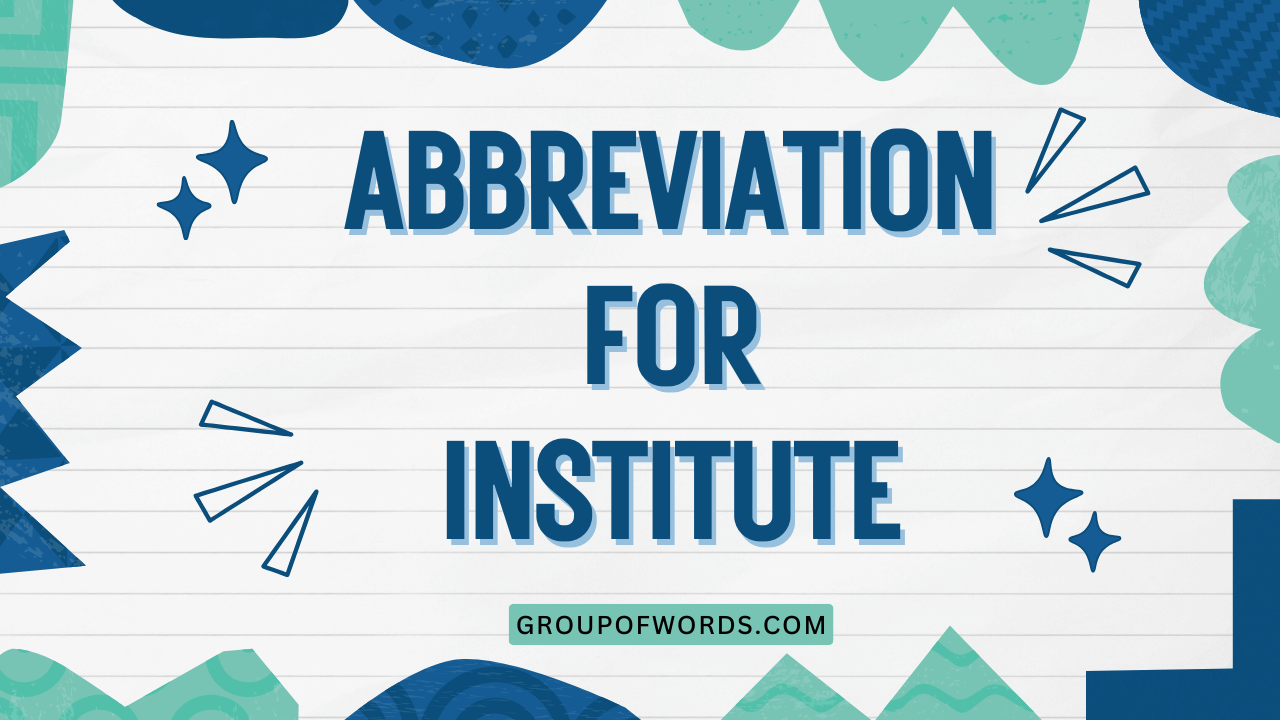Understanding Abbreviations for “Institute”: A Comprehensive Guide
Abbreviations are a common feature of the English language, allowing us to communicate more efficiently and concisely. When referring to “institute,” there are several accepted abbreviations, each with its own specific context and usage.
Mastering these abbreviations is crucial for clear and effective communication, especially in academic, professional, and technical settings. This article provides a detailed exploration of the abbreviations for “institute,” covering their definitions, structural breakdown, usage rules, common mistakes, and practical applications.
Whether you’re a student, researcher, or professional, this guide will equip you with the knowledge and skills to use these abbreviations correctly and confidently.
This comprehensive guide will delve into the various forms of abbreviation for institute, providing clarity and practical examples to enhance your understanding. We aim to make this topic accessible to learners of all levels, from beginners to advanced English speakers.
By the end of this article, you’ll be well-versed in the nuances of abbreviating “institute” and ready to apply this knowledge effectively in your writing and speech.
Table of Contents
- Definition of “Institute”
- Structural Breakdown of Abbreviations
- Types and Categories of Abbreviations
- Examples of Abbreviations in Use
- Usage Rules and Guidelines
- Common Mistakes to Avoid
- Practice Exercises
- Advanced Topics: Regional Variations and Formal vs. Informal Usage
- Frequently Asked Questions
- Conclusion
Definition of “Institute”
An institute is generally defined as an organization established for a specific purpose, especially for research or education. It can also refer to a training college or a place where a particular activity is carried out. The term often implies a degree of formality and specialization, suggesting a structured environment dedicated to the pursuit of knowledge, skills, or specific objectives.
Institutes can be found in various fields, including science, technology, arts, and social sciences. They play a crucial role in advancing knowledge, developing expertise, and contributing to societal progress.
Understanding the context in which “institute” is used is essential for choosing the appropriate abbreviation.
Structural Breakdown of Abbreviations
Abbreviations for “institute” typically involve shortening the word while retaining its essential meaning. The most common abbreviation is “Inst.,” which uses the first four letters of the word followed by a period.
The period signifies that the word has been abbreviated. Another common form is “Inst,” without the period, which is increasingly accepted, especially in informal contexts.
Understanding these structural elements helps in recognizing and using the abbreviations correctly.
The use of capitalization also plays a role. When “institute” is part of a proper noun (e.g., “Massachusetts Institute of Technology”), the abbreviation is usually capitalized (e.g., “MIT”).
However, when “institute” is used as a common noun, the abbreviation is typically lowercase (e.g., “the inst. for advanced studies”).
Types and Categories of Abbreviations
There are two primary types of abbreviations for “institute”:
1. Abbreviation with a Period: “Inst.”
This is the more traditional and formal abbreviation. The period indicates that the word has been shortened, providing a clear signal to the reader.
2. Abbreviation without a Period: “Inst”
This is a more modern and informal abbreviation. It is often used in contexts where brevity is prioritized, such as in online communication or technical documentation.
While increasingly common, it’s essential to consider the audience and context when using this form.
Examples of Abbreviations in Use
The following examples illustrate the use of “Inst.” and “Inst” in various contexts. These examples are categorized to provide a clear understanding of how these abbreviations are applied in different situations.
Table 1: Examples of “Inst.” in Formal Contexts
This table presents examples of the abbreviation “Inst.” used in formal writing, such as academic papers, official reports, and business correspondence.
| Example | Context |
|---|---|
| The research was conducted at the National Cancer Inst. | Academic research paper |
| The report was submitted to the Inst. of Electrical Engineers. | Official report |
| Please contact the Inst. for further information. | Business correspondence |
| The Inst.’s annual budget was approved by the board. | Meeting minutes |
| Prof. Smith is a fellow at the Advanced Studies Inst. | Academic profile |
| The seminar will be held at the Geological Inst. | Conference announcement |
| The Inst. is renowned for its groundbreaking research. | Promotional material |
| The policy was developed by the Inst. of Public Policy. | Government document |
| The Inst. has a long history of innovation. | Company history |
| The training program is offered by the Inst. of Technology. | Educational brochure |
| The Inst. is located in the heart of the city. | Location description |
| The Inst. provides a range of services to the community. | Community outreach |
| The Inst. is committed to excellence in research. | Mission statement |
| The Inst. is a leading provider of professional development. | Professional development |
| The Inst.’s website provides more details. | Website reference |
| The Inst. is a member of the international consortium. | International collaboration |
| The Inst. is funded by a grant from the government. | Funding information |
| The Inst. is accredited by the relevant authorities. | Accreditation details |
| The Inst. is dedicated to advancing knowledge in the field. | Research focus |
| The Inst. publishes a quarterly journal. | Publication details |
| The Inst. welcomes applications from qualified candidates. | Job advertisement |
| The Inst. is an equal opportunity employer. | Employment policy |
| The Inst. adheres to the highest ethical standards. | Ethical guidelines |
Table 2: Examples of “Inst” in Informal Contexts
This table provides examples of the abbreviation “Inst” used in informal settings, such as internal emails, notes, and less formal reports. Note how the absence of the period contributes to a more relaxed tone.
| Example | Context |
|---|---|
| Check out the latest research from the Marine Biology Inst. | Internal email |
| The meeting is at the Engineering Inst. | Quick note |
| I’m presenting at the Physics Inst next week. | Casual conversation |
| Did you see the new program at the Art Inst? | Informal report |
| The Inst is hiring interns for the summer. | Internal announcement |
| The Inst’s new website is live! | Team update |
| Let’s grab coffee near the Language Inst. | Arranging a meeting |
| The Inst has a great reputation. | General discussion |
| Visited the Historical Research Inst yesterday. | Personal communication |
| The Inst offers free workshops. | Promotional material |
| The Inst is hosting a conference next month. | Event announcement |
| The Inst’s library is open to the public. | Public service announcement |
| The Inst is committed to sustainability. | Sustainability report |
| The Inst offers courses in renewable energy. | Course catalog |
| The Inst is conducting a survey on climate change. | Survey invitation |
| The Inst is seeking volunteers for a research project. | Volunteer opportunity |
| The Inst is collaborating with other organizations. | Partnership announcement |
| The Inst is a leader in its field. | Industry recognition |
| The Inst is located in a convenient location. | Location information |
| The Inst has a diverse and inclusive workforce. | Diversity statement |
| The Inst is dedicated to serving the community. | Community service |
| The Inst is committed to providing quality education. | Educational philosophy |
| The Inst is a valuable resource for students. | Student support |
| The Inst is constantly evolving to meet the needs of its students. | Continuous improvement |
Table 3: Examples of Abbreviations in Proper Nouns
This table illustrates how “Inst.” and “Inst” are used within the names of specific institutes. Note the capitalization of the first letter in these cases.
| Example | Context |
|---|---|
| MIT (Massachusetts Inst. of Technology) | Commonly used abbreviation |
| Caltech (California Inst. of Technology) | Another well-known example |
| The Salk Inst. for Biological Studies | Research institute name |
| Woods Hole Oceanographic Inst. | Oceanographic institute |
| The Inst. for Advanced Study | Proper noun |
| The Inst. of Contemporary Art | Museum name |
| The Inst. of Chartered Accountants | Professional organization |
| The Gemological Inst. of America | Educational institution |
| The Petroleum Inst. | Industry-specific institute |
| The Smithsonian Inst. | Cultural institution |
| The Inst. for Justice | Legal organization |
| The Inst. of Internal Auditors | Professional association |
| The Inst. of Management Accountants | Accounting organization |
| The Clay Mathematics Inst. | Mathematics research |
| The Inst. of Electrical and Electronics Engineers (IEEE) | Engineering association |
| The Inst. of Mechanical Engineers (IMechE) | Mechanical engineering |
| The Inst. of Physics (IOP) | Physics organization |
| The Inst. of Civil Engineers (ICE) | Civil engineering |
| The Inst. of Chemical Engineers (IChemE) | Chemical engineering |
| The Inst. of Materials, Minerals and Mining (IOM3) | Materials science |
| The Inst. of Directors (IoD) | Business leadership |
| The Inst. of Fundraising (IoF) | Fundraising organization |
| The Inst. of Customer Service (ICS) | Customer service |
| The Inst. of Export & International Trade (IEIT) | International trade |
Table 4: Examples of Correct and Incorrect Usage
This table highlights the correct and incorrect uses of the abbreviations, emphasizing the importance of context and consistency.
| Incorrect | Correct | Explanation |
|---|---|---|
| The inst for research is well-funded. | The Inst. for research is well-funded. | Capitalization is needed when referring to a specific institute by name. |
| The report was sent to Inst.. | The report was sent to Inst. | Avoid double periods. |
| The Inst of technology is nearby. | The Inst. of Technology is nearby. | Use the period in formal writing. |
| The program at the Inst is great. | The program at the Inst. is great. | Period indicates abbreviation in formal writing. |
| He works for the research inst. | He works for the research inst. | Lowercase “inst” is acceptable in informal contexts. |
| She attended the Inst. | She attended the Inst. | Correct use of “Inst.” |
| We visited the Inst. yesterday. | We visited the Inst. yesterday. | Correct use of “Inst.” |
| They are studying at the Inst. | They are studying at the Inst. | Correct use of “Inst.” |
| The course is offered by the Inst. | The course is offered by the Inst. | Correct use of “Inst.” |
| The conference is hosted by the Inst. | The conference is hosted by the Inst. | Correct use of “Inst.” |
| The Inst has a new director. | The Inst. has a new director. | Use the period in formal writing. |
| The Inst website is down. | The Inst.’s website is down. | Apostrophe needed for possessive form. |
| Inst’s research is groundbreaking. | The Inst.’s research is groundbreaking. | Capitalization needed for a specific institute. |
| The inst located downtown is popular. | The institute located downtown is popular. | Use the full word when being general. |
| The inst program is well-regarded. | The inst program is well-regarded. | Lowercase “inst” is acceptable in informal contexts. |
| The Inst.s mission is clear. | The Inst.’s mission is clear. | Apostrophe needed for possessive form. |
| The inst. mission is clear. | The inst.’s mission is clear. | Apostrophe needed for possessive form. |
| The insts are all well-known. | The institutes are all well-known. | Use the full word when referring to multiple institutes generally. |
| We work closely with many inst. | We work closely with many institutes. | Use the full word when referring to multiple institutes generally. |
| The inst. main building is historic. | The Inst.’s main building is historic. | Capitalization needed for a specific institute, and apostrophe for possessive. |
Usage Rules and Guidelines
Using abbreviations correctly requires adherence to certain rules and guidelines. These rules ensure clarity, consistency, and proper communication.
1. Formal vs. Informal Contexts: Use “Inst.” in formal writing and “Inst” in informal contexts.
2. Capitalization: Capitalize the first letter when the abbreviation is part of a proper noun.
3. Periods: Include a period after “Inst.” in formal writing.
4. Consistency: Maintain consistency in your choice of abbreviation throughout a document.
5. Clarity: Ensure that the abbreviation is easily understood within the context. If there’s a risk of ambiguity, use the full word “institute.”
6. Possessive Form: Use an apostrophe to indicate the possessive form (e.g., “The Inst.’s research”).
Common Mistakes to Avoid
Several common mistakes can occur when using abbreviations for “institute.” Being aware of these mistakes can help you avoid them and ensure accuracy in your writing.
1. Incorrect Capitalization: Failing to capitalize the first letter when referring to a specific institute by name.
2. Missing Period: Omitting the period after “Inst.” in formal writing.
3. Double Periods: Using two periods (e.g., “Inst..”)
4. Inconsistency: Switching between “Inst.” and “Inst” within the same document.
5. Lack of Clarity: Using the abbreviation in a context where its meaning is unclear.
6. Incorrect Possessive Form: Forgetting the apostrophe in the possessive form (e.g., writing “The Inst research” instead of “The Inst.’s research”).
7. Overuse of Abbreviations: Relying too heavily on abbreviations, which can make your writing difficult to read.
Practice Exercises
The following practice exercises will help you reinforce your understanding of the abbreviations for “institute.” Each exercise includes multiple questions with answers provided below.
Exercise 1: Fill in the Blanks
Fill in the blanks with the correct abbreviation (“Inst.” or “Inst”) or the full word “institute,” depending on the context.
| Question | Answer |
|---|---|
| 1. The report was submitted to the ____ of Technology. | Inst. |
| 2. I’m presenting at the Physics ____ next week. | Inst |
| 3. The ____ for Advanced Study is a renowned research center. | Institute |
| 4. The ____’s annual budget was approved. | Inst. |
| 5. Check out the new program at the Art ____. | Inst |
| 6. He works at the marine biology ____. | inst |
| 7. The training is offered by the ____ of Engineering. | Inst. |
| 8. The ____ is located downtown. | Institute |
| 9. She is a fellow at the research ____. | Inst. |
| 10. The ____ website provides more details. | Inst.’s |
Exercise 2: Correct the Errors
Identify and correct the errors in the following sentences related to the abbreviations for “institute.”
| Question | Answer |
|---|---|
| 1. The inst for research is well-funded. | The Inst. for research is well-funded. |
| 2. The report was sent to Inst.. | The report was sent to Inst. |
| 3. The Inst of technology is nearby. | The Inst. of Technology is nearby. |
| 4. The program at the Inst is great. | The program at the Inst. is great. |
| 5. The Insts mission is clear. | The Inst.’s mission is clear. |
| 6. We visited the inst yesterday. | We visited the inst yesterday. (Correct) |
| 7. The inst. website is informative. | The inst website is informative. |
| 8. She works at the Inst. of Science. | She works at the Inst. of Science. (Correct) |
| 9. The policy was developed by the Inst of Public Policy. | The policy was developed by the Inst. of Public Policy. |
| 10. The Inst. main building is historic. | The Inst.’s main building is historic. |
Advanced Topics: Regional Variations and Formal vs. Informal Usage
While the basic rules for abbreviating “institute” remain consistent, there can be subtle regional variations and differences in usage between formal and informal contexts.
Regional Variations: In some regions, the use of “Inst” without a period may be more widely accepted than in others. It’s essential to be aware of the conventions in the specific region where you are communicating.
Formal vs. Informal Usage: As previously mentioned, “Inst.” is generally preferred in formal writing, while “Inst” is more common in informal settings. However, the level of formality can vary depending on the audience and purpose of the communication. In highly formal documents, it might be best to avoid abbreviations altogether and use the full word “institute.”
Frequently Asked Questions
Here are some frequently asked questions about the abbreviations for “institute,” along with detailed answers to help clarify any remaining doubts.
1. Is it always necessary to use a period after “Inst.”?
In formal writing, yes, it is generally necessary to use a period after “Inst.” to indicate that the word has been abbreviated. However, in informal contexts, the period is often omitted.
2. When should I capitalize the abbreviation “Inst.”?
You should capitalize the first letter of the abbreviation when it is part of a proper noun, such as the name of a specific institute (e.g., “The Inst. of Technology”).
3. Can I use “Inst” without a period in formal writing?
While increasingly common, it’s generally best to avoid using “Inst” without a period in formal writing. Stick to “Inst.” to maintain a formal tone.
4. What if I’m unsure whether to use the abbreviation or the full word?
If you’re unsure, it’s always better to err on the side of caution and use the full word “institute.” This ensures clarity and avoids any potential confusion.
5. How do I indicate the possessive form of the abbreviation?
Use an apostrophe followed by “s” to indicate the possessive form (e.g., “The Inst.’s research”).
6. Is there a difference between “Inst.” and “inst.”?
Yes, the capitalization matters. “Inst.” is used when referring to a specific institute or as part of a proper noun. “inst.” (lowercase) might be acceptable in very informal contexts but is generally discouraged in formal writing.
7. Can I use abbreviations excessively in my writing?
No, it’s generally not a good idea to overuse abbreviations. While they can be useful for brevity, too many abbreviations can make your writing difficult to read and understand. Use them sparingly and only when necessary.
8. Are there any specific style guides that provide rules for abbreviating “institute”?
Yes, style guides such as the AP Stylebook and the Chicago Manual of Style provide guidelines for abbreviations. Consult these guides for specific rules and recommendations.
Conclusion
Mastering the abbreviations for “institute” is essential for clear and effective communication in various contexts. By understanding the definitions, structural breakdown, usage rules, and common mistakes associated with these abbreviations, you can confidently use them in your writing and speech.
Remember to consider the context, audience, and level of formality when choosing between “Inst.,” “Inst,” and the full word “institute.”
This comprehensive guide has provided you with the knowledge and tools to navigate the nuances of abbreviating “institute.” Continue to practice and apply these principles in your writing to further enhance your understanding and proficiency. With consistent effort, you’ll be well-equipped to use these abbreviations correctly and effectively, contributing to clearer and more professional communication.






